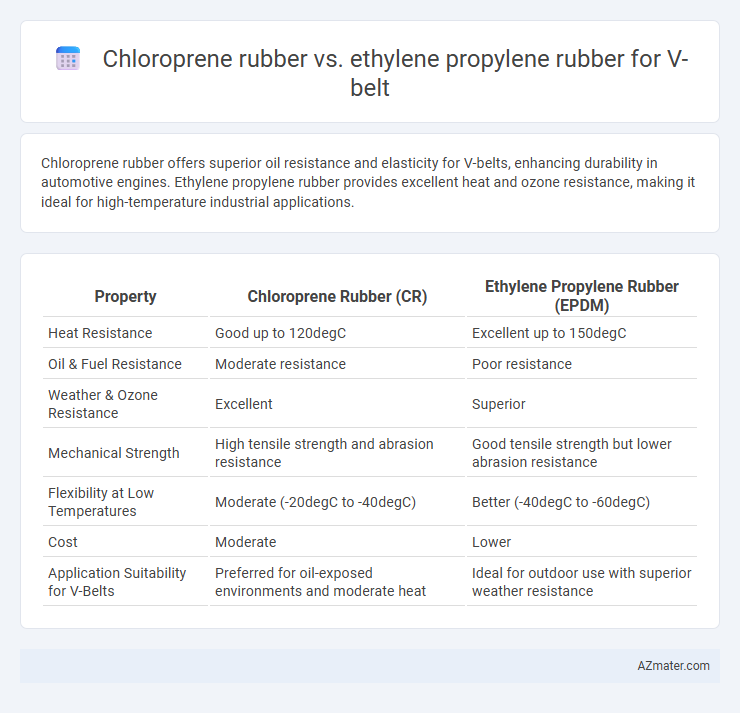Chloroprene rubber offers superior oil resistance and elasticity for V-belts, enhancing durability in automotive engines. Ethylene propylene rubber provides excellent heat and ozone resistance, making it ideal for high-temperature industrial applications.
Table of Comparison
| Property | Chloroprene Rubber (CR) | Ethylene Propylene Rubber (EPDM) |
|---|---|---|
| Heat Resistance | Good up to 120degC | Excellent up to 150degC |
| Oil & Fuel Resistance | Moderate resistance | Poor resistance |
| Weather & Ozone Resistance | Excellent | Superior |
| Mechanical Strength | High tensile strength and abrasion resistance | Good tensile strength but lower abrasion resistance |
| Flexibility at Low Temperatures | Moderate (-20degC to -40degC) | Better (-40degC to -60degC) |
| Cost | Moderate | Lower |
| Application Suitability for V-Belts | Preferred for oil-exposed environments and moderate heat | Ideal for outdoor use with superior weather resistance |
Introduction to V-Belt Materials
Chloroprene rubber (CR) and Ethylene Propylene Rubber (EPR) are prominent materials used in V-belt manufacturing due to their distinct mechanical properties and chemical resistance. CR offers superior oil and abrasion resistance, making it suitable for heavy-duty applications exposed to harsh environments, while EPR provides excellent heat resistance and flexibility, ideal for high-temperature conditions. Selecting the appropriate rubber compound impacts the V-belt's durability, performance efficiency, and operational lifespan across diverse industrial settings.
Overview of Chloroprene Rubber
Chloroprene rubber (CR) offers excellent resistance to oil, ozone, weathering, and abrasion, making it a preferred material for V-belt applications in harsh environments. Its good mechanical strength and flexibility ensure reliable power transmission and durability under varying temperatures. Compared to ethylene propylene rubber (EPR), CR provides superior heat aging properties and chemical resistance, enhancing V-belt longevity and performance.
Overview of Ethylene Propylene Rubber (EPR/EPDM)
Ethylene Propylene Rubber (EPR/EPDM) is a synthetic elastomer known for its excellent resistance to heat, oxidation, weathering, and ozone, making it ideal for V-belt applications exposed to harsh environments. EPDM offers superior flexibility and durability at a wide temperature range, typically from -50degC to 150degC, outperforming Chloroprene rubber in UV and chemical resistance, which enhances the V-belt's lifespan and reliability. Its low compression set and strong mechanical properties contribute to efficient power transmission with minimal maintenance in automotive and industrial V-belt systems.
Mechanical Properties Comparison
Chloroprene rubber (CR) offers superior tensile strength and excellent abrasion resistance compared to Ethylene Propylene Rubber (EPR), making it more suitable for high-stress V-belt applications. EPR provides better resistance to heat, ozone, and weathering, maintaining flexibility under extreme temperatures, but generally exhibits lower mechanical durability. The choice between CR and EPR for V-belts depends on balancing the need for mechanical robustness against environmental exposure resilience.
Chemical Resistance Analysis
Chloroprene rubber (CR) exhibits superior chemical resistance against oils, fuels, and weathering agents, making it ideal for V-belts in automotive and industrial environments prone to exposure to hydrocarbons. Ethylene propylene rubber (EPR) offers excellent resistance to water, steam, and polar solvents but performs poorly against oils and greases, limiting its use in V-belt applications requiring oil resistance. CR's balanced chemical stability and mechanical properties ensure longer V-belt lifespan where exposure to diverse aggressive chemicals is expected.
Temperature Resistance and Durability
Chloroprene rubber offers excellent temperature resistance, typically withstanding continuous exposure up to 120degC, making it suitable for high-heat V-belt applications. Ethylene propylene rubber (EPDM) provides superior durability with enhanced resistance to weathering, ozone, and chemical exposure, maintaining performance across a wide temperature range from -50degC to 150degC. EPDM V-belts are preferred in environments requiring prolonged flexibility and resistance to aging, while chloroprene belts excel in moderate heat conditions with reliable structural integrity.
Flexibility and Performance in Applications
Chloroprene rubber (CR) offers superior flexibility and excellent resistance to oils, heat, and weathering, making it ideal for V-belt applications in automotive and industrial environments requiring durability under varying temperatures. Ethylene propylene rubber (EPR) demonstrates outstanding flexibility and electrical insulation properties, with exceptional resistance to ozone and aging, which enhances performance in electric motor-driven V-belt systems and outdoor industrial settings. Both chloroprene and EPR provide reliable mechanical strength, but CR excels in oil resistance while EPR is preferred for environments demanding high resistance to oxidative degradation and flexibility at low temperatures.
Cost Efficiency and Availability
Chloroprene rubber offers superior resistance to oil, heat, and weathering, making it a cost-efficient choice for durable V-belts despite a higher initial material cost compared to Ethylene Propylene Rubber (EPR). Ethylene Propylene Rubber provides excellent resistance to heat and ozone at a lower cost, but its limited oil resistance can reduce lifespan in demanding V-belt applications, affecting overall cost efficiency. Chloroprene's widespread availability and balanced performance characteristics ensure better longevity and cost savings in industrial V-belt usage.
Industry-Specific Use Cases
Chloroprene rubber (CR) excels in V-belt applications requiring strong oil resistance, weather durability, and heat tolerance, making it ideal for automotive engines and heavy machinery in manufacturing industries. Ethylene propylene rubber (EPR) is preferred in electrical and chemical processing sectors where excellent ozone resistance and flexibility in harsh environments are critical. Industrial conveyors and agricultural equipment benefit from CR's abrasion resistance, while EPR suits food processing and pharmaceutical environments due to its superior chemical inertness and non-toxic properties.
Conclusion: Choosing the Right Rubber for V-Belts
Chloroprene rubber offers superior resistance to oil, heat, and weather, making it ideal for V-belts in industrial applications with harsh environments. Ethylene propylene rubber excels in resisting ozone, moisture, and aging, providing long-lasting performance in outdoor or high-humidity conditions. Selecting the right rubber depends on the specific operating conditions, where chloroprene suits heavy-duty, oil-exposed settings and ethylene propylene is preferred for durable, weather-resistant V-belts.

Infographic: Chloroprene rubber vs Ethylene propylene rubber for V-belt
 azmater.com
azmater.com